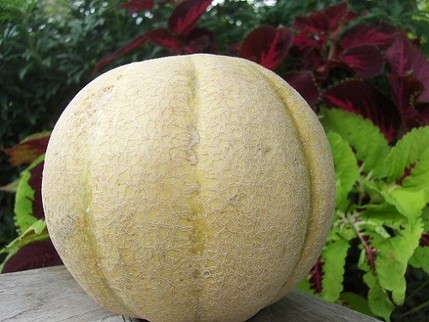|
The French poet, Claude Mermet, was obviously a melon connoisseur. He is often quoted as saying that there were three things that mediocrity would not support: poetry, wine and melons. He also compared good melons to good friends. Sounds right. Then again, who would have thought that such a sweet disposition as that of the fragrant ripe cantaloupe would be the cause of so much debate and disagreement? It is reported widely that what Americans call cantaloupe is actually a muskmelon, or occasionally rockmelon. Accordingly, the European variety is reputed to be the true cantaloupe. This claim springs from a myth about how the name came to be. The story goes that this melon was first formally cultivated at Castello Cantalupo, the country villa of Pope Celestine V in the 16thC. Not atypically, there are many places in Italy bearing that or some variant of that name. Even a couple in France. Reports and terminology may conflict but both melons are sweet, orange-fleshed and carry their seeds in an internal cavity. The primary difference is that the rind of the American muskmelon has a very ropey netting, while the European cantaloupe is a veined but smooth skinned globe. Both are members of the cucurbitaceae family and kin to the cucumber and the watermelon. Likewise, both varieties are believed to have originated in Persia. Though it is a quite a stretch to believe such consistency could travel the centuries intact, musk is the Persian word for perfume. The inevitable Romans had their hands in the distribution and propagation of this fruit, and like many conquerors, documented every aspect of their takeover, including the propagation of the melon. Inexplicably, the cantaloupe-muskmelon nearly disappeared from Europe after the fall of Rome. Marco Polo found the fruit in Persia in the 12thC. He noted that the Persians dried long strips of the melon in the sun to intensify their sweetness and render them transportable. The Moors had reintroduced the melon to Andalusian Spain in the 8thC, but it wasn’t cultivated again in Italy and the rest of Europe until the 14thC. Waverly Root wrote that in Renaissance France the juicy orb was the height of food fashion. So much so that the entire country was perfumed with its fragrance. Once the orange-fleshed melon re-conquered Europe, Christopher Columbus carried it to the New World where it was promptly adopted across the American continents. Inexplicably, it was not commercially cultivated in the U.S. until 1895. Though most of us would automatically wash our vegetables, I for one frequently forget that food authorities recommend the same treatment for melons before they are cut open. It’s hard to improve on the perfection of a freshly cut melon. Still, a splash of lime juice or a sprinkle of ground ginger will have your taste buds saluting. In previous publications we’ve provided a recipe for Cantaloupe in Red Wine Syrup and Cantaloupe Mint Granita. Today we’re taking a more savory approach with Grilled Cantaloupe with Feta and Mint.
0 Comments
Leave a Reply. |




